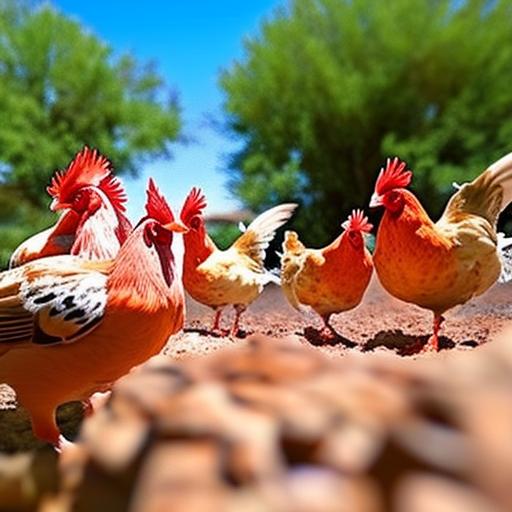Raising chickens in Arizona’s hot climate can present unique challenges. With temperatures often soaring above 100 degrees Fahrenheit during the summer months, it is important for chicken owners to understand the impact of heat on their feathered friends. Heat stress and heatstroke can be serious conditions for chickens, and it is crucial to take steps to prevent these illnesses. In this article, we will explore the effects of heat on chickens, discuss ways to keep them cool and comfortable, and provide tips on how to prepare your chickens for Arizona’s hot summers.
Key Takeaways
- Heat can have a significant impact on chickens in Arizona, leading to heat stress and even death.
- Choosing heat-tolerant breeds like Leghorns and Rhode Island Reds can help chickens thrive in hot climates.
- Providing adequate shade and ventilation in chicken coops is crucial for keeping chickens cool and comfortable.
- Creating a cool dust bathing area and offering fresh, cool water can also help chickens beat the heat.
- Using frozen treats and adjusting feeding schedules can further help prevent heat stress in chickens.
Understanding the Impact of Heat on Chickens in Arizona
Chickens, like humans, are warm-blooded animals that need to regulate their body temperature. However, unlike humans, chickens do not have sweat glands. Instead, they rely on other methods to cool down. Chickens pant to release heat from their bodies and regulate their internal temperature. They also spread their wings and hold them away from their bodies to increase air circulation.
When temperatures rise above 90 degrees Fahrenheit, chickens can experience heat stress. This can lead to a decrease in egg production, reduced appetite, and even death if not addressed promptly. Heatstroke is a more severe condition that occurs when a chicken’s body temperature rises above 107 degrees Fahrenheit. Signs of heatstroke include labored breathing, lethargy, and disorientation.
To prevent heat-related illnesses in chickens, it is important to provide them with a cool and comfortable environment. This includes providing shade, proper ventilation, and access to fresh water at all times.
Choosing the Right Breeds for Arizona’s Hot Climate
Not all chicken breeds are well-suited for hot climates like Arizona’s. Some breeds are better adapted to handle the heat than others. When choosing breeds for your flock, consider selecting those that are known for their heat tolerance.
Some chicken breeds that are well-suited for hot climates include:
1. Rhode Island Reds: These chickens have a single comb, which allows for better heat dissipation. They are also known for their hardiness and ability to withstand hot temperatures.
2. Leghorns: Leghorns are known for their heat tolerance and ability to lay eggs consistently even in hot weather. They have large combs and wattles, which help them release heat more efficiently.
3. Australorps: Australorps are known for their ability to handle both hot and cold climates. They have a dense feather coat that helps insulate them from extreme temperatures.
These breeds are better adapted to handle the heat because of their physical characteristics, such as comb size and feather density. By choosing these breeds, you can increase the chances of your chickens staying comfortable in Arizona’s hot climate.
Providing Adequate Shade and Ventilation in Chicken Coops
| Metrics | Description |
|---|---|
| Temperature | Measure the temperature inside the coop to ensure it is not too hot or too cold for the chickens. |
| Humidity | Monitor the humidity levels to prevent the buildup of moisture which can lead to respiratory problems for the chickens. |
| Airflow | Ensure adequate ventilation to prevent the buildup of harmful gases and to provide fresh air for the chickens. |
| Shade | Provide shade for the chickens to prevent overheating and sunburn. |
| Roosting Space | Ensure there is enough roosting space for the chickens to rest comfortably. |
| Nesting Boxes | Provide nesting boxes for the chickens to lay their eggs in a safe and comfortable environment. |
Shade and ventilation are crucial for keeping chickens cool in hot weather. Without proper airflow and shade, the temperature inside a chicken coop can quickly rise to dangerous levels.
To create a well-ventilated coop, make sure there are enough windows or vents to allow for air circulation. You can also install fans to help move air around. Position the windows or vents strategically to take advantage of prevailing winds.
Shade is equally important. Provide shade in the chicken run by planting trees or installing shade cloth. In the coop itself, use materials that reflect sunlight, such as light-colored roofing materials or paint.
It is also important to monitor the temperature inside the coop regularly. Invest in a thermometer and check it frequently during hot weather. If the temperature inside the coop exceeds 90 degrees Fahrenheit, take immediate action to cool it down.
Creating a Cool Dust Bathing Area for Chickens
Dust bathing is an essential behavior for chickens, as it helps them keep their feathers clean and free from parasites. However, during hot weather, dust bathing can become uncomfortable for chickens if the ground is too hot.
To create a cool and comfortable dust bathing area for your chickens, provide a shaded spot with loose soil or sand. You can also add a shallow container filled with diatomaceous earth, which helps control parasites. Make sure the area is well-shaded and away from direct sunlight.
Offering Fresh and Cool Water to Chickens to Keep Them Hydrated

Hydration is crucial for chickens in hot weather. Chickens need access to fresh and cool water at all times to stay hydrated and regulate their body temperature.
To keep chicken water cool, consider using a waterer with a built-in ice pack or freeze water bottles and place them in the waterer. This will help keep the water temperature down, even in extreme heat.
It is also important to clean and refill the waterer regularly to prevent bacterial growth. Chickens are more likely to drink clean and fresh water, which will help them stay hydrated.
Using Frozen Treats to Keep Chickens Cool in Arizona
Frozen treats can be a fun and effective way to keep chickens cool during hot weather. These treats not only provide hydration but also help lower their body temperature.
Some ideas for frozen treats that chickens will love include:
1. Frozen fruit: Freeze berries, melons, or grapes and offer them as a refreshing treat. Just make sure to remove any seeds or pits that could be harmful to chickens.
2. Frozen vegetables: Freeze peas, corn, or chopped greens and offer them as a cool snack. Vegetables are not only hydrating but also provide essential nutrients for chickens.
3. Frozen yogurt: Mix plain yogurt with fruits or vegetables and freeze it in ice cube trays. This will provide a tasty and cooling treat for your chickens.
Remember to offer these treats in moderation, as too much can upset their digestive system.
Adjusting Feeding Schedules to Avoid Heat Stress in Chickens
Feeding schedules can have an impact on chickens’ ability to handle heat. During hot weather, it is best to adjust feeding schedules to avoid heat stress.
Chickens generate heat when digesting food, so feeding them during the cooler parts of the day can help reduce the overall heat load on their bodies. Consider feeding them early in the morning or late in the evening when temperatures are lower.
It is also important to provide a balanced diet that meets their nutritional needs. A well-balanced diet will help chickens maintain their overall health and better cope with heat stress.
Monitoring Chickens for Signs of Heat Stress and Heatstroke
It is crucial to monitor chickens for signs of heat stress and heatstroke, as these conditions can be life-threatening if not addressed promptly.
Signs of heat stress in chickens include:
– Panting
– Lethargy
– Reduced appetite
– Drooping wings
– Pale combs and wattles
If you notice any of these signs, take immediate action to cool down your chickens. Move them to a shaded area, provide fresh water, and offer frozen treats if available. If the symptoms persist or worsen, consult a veterinarian.
Signs of heatstroke in chickens include:
– Labored breathing
– Disorientation
– Seizures
– Collapse
Heatstroke is a medical emergency, and immediate action is required. Move the chicken to a cool area, immerse its feet in cool water, and mist its body with water. Contact a veterinarian for further guidance.
Implementing Emergency Cooling Measures for Chickens During Heat Waves
During extreme heat waves, it may be necessary to implement emergency cooling measures to keep chickens safe.
Some emergency cooling measures include:
1. Misting or spraying chickens with cool water: Use a spray bottle or hose with a fine mist setting to spray chickens with cool water. This will help lower their body temperature.
2. Using fans or misting systems: Install fans or misting systems in the chicken coop or run to provide additional cooling. Make sure the fans are positioned to provide airflow without causing drafts.
3. Creating ice blocks: Freeze large blocks of ice and place them in the chicken run or coop. Chickens can lean against the ice blocks to cool down.
Remember to monitor the chickens closely during extreme heat and adjust these measures as needed.
Planning Ahead for Arizona’s Hot Summers: Preparing Your Chickens for the Heat
To prepare your chickens for Arizona’s hot summers, it is important to plan ahead and take proactive measures.
Some additional tips for preparing your chickens for the heat include:
1. Providing additional shade: Consider installing shade sails or awnings in the chicken run to provide extra shade during the hottest parts of the day.
2. Using reflective materials: Use reflective materials on the roof of the chicken coop to reduce heat absorption. This can help keep the coop cooler during hot weather.
3. Offering electrolytes: During extreme heat, consider adding electrolytes to your chickens’ water to help replace lost minerals and maintain hydration.
4. Allowing free-ranging during cooler parts of the day: If possible, allow your chickens to free-range during early morning or late evening when temperatures are lower. This will give them access to cooler areas and fresh vegetation.
By planning ahead and implementing these measures, you can help ensure that your chickens stay cool and comfortable during Arizona’s hot summers.
Raising chickens in Arizona’s hot climate requires careful attention to their needs and well-being. By understanding the impact of heat on chickens, choosing heat-tolerant breeds, providing adequate shade and ventilation, offering cool dust bathing areas and fresh water, using frozen treats, adjusting feeding schedules, monitoring for signs of heat stress and heatstroke, implementing emergency cooling measures, and planning ahead for hot summers, you can help keep your chickens cool and comfortable.
Remember, the well-being of your chickens is in your hands. Take the necessary steps to provide them with a safe and comfortable environment during hot weather. Your chickens will thank you for it, and you will have healthier and happier birds.
If you’re a chicken owner in Arizona, you know how important it is to keep your feathered friends cool during the scorching summer months. Luckily, there are plenty of ways to ensure their comfort and well-being. One helpful resource is an article on Poultry Wizard’s website titled “Tips for Keeping Chickens Cool in Arizona.” This article provides valuable insights and practical advice on how to create a chicken coop that offers optimal ventilation and shade. It also discusses the importance of providing fresh water and implementing cooling techniques such as misters or frozen treats. Check out the article here to learn more about keeping your chickens cool in the Arizona heat.
FAQs
What is the ideal temperature range for chickens?
Chickens are comfortable in temperatures ranging from 50-80 degrees Fahrenheit. Anything above 90 degrees Fahrenheit can be dangerous for them.
How can I keep my chickens cool in Arizona?
You can keep your chickens cool in Arizona by providing them with shade, plenty of water, and good ventilation. You can also use misters or fans to help lower the temperature in their coop.
What are the signs of heat stress in chickens?
Signs of heat stress in chickens include panting, lethargy, loss of appetite, and a drop in egg production. In severe cases, chickens may collapse or die.
What should I do if my chickens are showing signs of heat stress?
If your chickens are showing signs of heat stress, move them to a cooler area immediately. Provide them with cool water and electrolytes to help rehydrate them. You can also use a fan or misters to help cool them down.
Can I give my chickens ice water to help cool them down?
No, you should not give your chickens ice water to help cool them down. Cold water can shock their system and cause them to go into shock. Instead, provide them with cool, fresh water.
What breeds of chickens are best suited for hot climates?
Breeds of chickens that are best suited for hot climates include Leghorns, Rhode Island Reds, and Sussex. These breeds are known for their heat tolerance and ability to thrive in hot weather.
Meet Walter, the feathered-friend fanatic of Florida! Nestled in the sunshine state, Walter struts through life with his feathered companions, clucking his way to happiness. With a coop that’s fancier than a five-star hotel, he’s the Don Juan of the chicken world. When he’s not teaching his hens to do the cha-cha, you’ll find him in a heated debate with his prized rooster, Sir Clucks-a-Lot. Walter’s poultry passion is no yolk; he’s the sunny-side-up guy you never knew you needed in your flock of friends!







